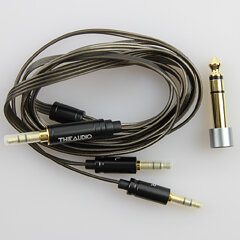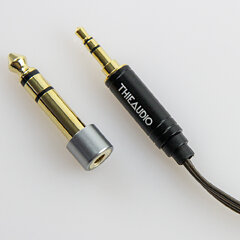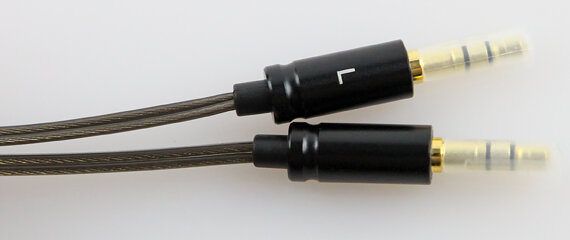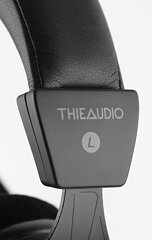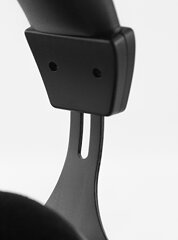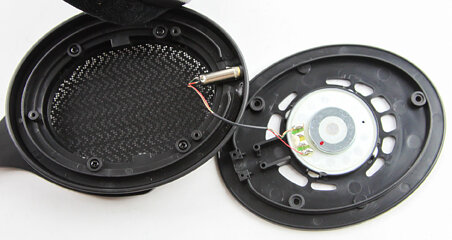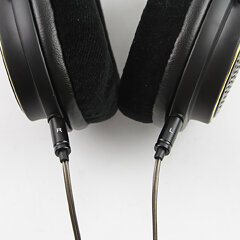 7
7
Quick Look: ThieAudio Ghost Open-Back Dynamic Driver Headphones
(7 Comments) »Introduction

ThieAudio has a soft spot in my heart given it was the brand that kick-started my frequency response measurements for earphones and headphones nearly two years ago. Indeed, the months since have led to several ThieAudio product reviews, with more on the way. You will note how the vast majority of ThieAudio products tend to be in-ear monitors, or IEMs as more commonly referred to, which are earphones that are currently in a golden period of R&D to where IEMs from even 2-3 years ago are hard to justify for the money as better sets come up for less all the time. ThieAudio has been part of this journey too, with the V16 Divinity and Elixir being two of my preferred IEMs ever tested. The same could not be said about ThieAudio headphones though, with the recently tested Wraith planar magnetic set showing great potential but in need of better drivers and tuning. ThieAudio clearly agreed on its IEM tuning prowess not yet being replicated with headphones and promised improvement with its latest venture into the over-ear headphones space.

Today we take a look at the ThieAudio Ghost, a dynamic driver set of headphones which joins the Phantom and Wraith—I see a Rolls Royce naming scheme ongoing here—to be ThieAudio's third-only such headphones. This is also the least expensive headphones from the brand with a novel sapphire dynamic driver and a design scheme that certainly reminds me of a few other successful headphones. Would the ThieAudio Ghost prove to everyone that the Linsoul house brand can do more than just IEMs? Thanks to Linsoul for providing a review sample to TechPowerUp to help answer this question, as we begin our coverage with a look at the product specifications in the table below.
| ThieAudio Ghost Headphones | |
|---|---|
| Materials: | Steel band, plastic frame, faux leather headband cover, velour ear pads with foam filling |
| Transducer Principle: | Open-back, over-ear, dynamic |
| Frequency Response: | 20 Hz–40 kHz |
| Sensitivity: | 91 dB/mW |
| Impedance: | 60 Ω |
| Cable: | Dual 3.5 mm TRS from headphones to 3.5 mm TRS connector to source |
| Weight (without cable): | ~250 g |
| Warranty: | One year |
Packaging and Accessories
The ThieAudio Ghost ships in an average-sized product box, which itself was surprising since I expected something more barebones in track with this being a more wallet-friendly product. I am glad to see the nice packaging design has not been forgotten here though, with a cool render of the headphones on the front to go with the product name and the new ThieAudio logo itself. Salient features are also listed here and a more blown-out render of the headphones are seen on the back—almost as if it were the ghost of the headphones! Product specs and more branding are seen on the sides of this outer sleeve which can be slid out to reveal a plastic 2-piece thick cardboard box inside. Take off the lid and now we see an actual hard carry case with further protection around it and the user manual underneath, this is shaping up to be quite a good unboxing experience already!
ThieAudio includes a nice carry/storage case with the Ghost that is even sculpted to better fit the headphones inside—the top is narrower than the bottom, for example. It's a hard case in black and has a carry strap that you can also hook via a carabiner to your backpack, if you do not wish to place it inside. The zipper tag is on the more substantial side even if it's made of plastic and I appreciate the self-sealing zippers that add dust and spill resistance on top. Open the case to reveal soft lining on the inside with the headphones neatly packed over a separate netted-compartment that houses the cable accessories.
Closer Look
With ThieAudio going further than I expected on the packaging and accessories front, I suppose it wasn't a surprise to see the Ghost ship with a less-fancy cable itself. It uses a 3.5 mm single-ended connector headed to your source—ThieAudio also provides a 3.5 mm to 6.35 mm (1/4") adapter—and employs a flat, ribbon-style design for the actual cable. We don't get any details about the cable on the product page so I can only speculate it's using pure copper as the conductor. The brown 4-strand cable is paired with black housing throughout and then two strands each head to the headphones side where we get dual 3.5 mm connectors with L/R markings to help distinguish the left and right channels, respectively. The cable can get into a tangle easier than I'd like and can be slightly microphonic to where I can actually see people getting frustrated with this and opting for an aftermarket cable—I highly recommend the Tripowin Granvia if you can afford it. The metal plugs are gold-plated for oxidation resistance and come with plastic covers you need to remove prior to use.
The ThieAudio Ghost is an open-back, over-ear set of headphones whose design reminds me of a few Sennheiser sets. This isn't a matter of something aiming to be a clone however, and if the end result gets you a product which is worthy of said comparison in terms of build quality and comfort then all the better. It's a predominantly black set which is extremely light in the hands but does feel somewhat cheap too. The frame being plastic might be part of this, although the internal headband structure could be steel. There's a faux leather cover over the headband itself which is stitched fairly well and has foam filling for comfort. There's ThieAudio branding on the outside where the headband meets the yokes/frame—perhaps some inspiration is taken from the Shure SRH1540/1840 here—and we also find L/R markings for channel identification here. Vertical sizing is done by simply pulling the yokes out from the leather covering, exposing a central cutout the headband slides over. This allows for a good amount of sizing leeway for various head sizes but is not the easiest to match up on both sides. The bigger issue is the lack of any ear cup swivel or tilt making the ThieAudio Ghost less user-friendly in achieving the best possible fit, although the company has added in some foam dampeners to minimize the noise from the ear cups hitting the plastic frame itself.
There is a deliberate design on the frame but your eyes will no doubt be swayed towards the grills on the ear cups, and perhaps now you might well think the HD 580 has been the inspiration for the Ghost. I do like the simpler geometric patterns employed here and the gold accent around the grill adds some bling in a subtle manner to help break up the monotony otherwise. The ThieAudio Ghost comes with one set of ear pads but they are easy enough to remove and replace with aftermarket pads. Removing an ear pad also provides a closer look at the 40 mm dynamic driver used here which does look quite neat and different from the norm owing to its novel composition. After all testing was finished, I opened up one of the ear cups for further inspection inside wherein we see two extremely thin wires used from the cable connector to the driver itself. Solder quality could have been better too, and otherwise this is a fairly typical dynamic driver design with the surround and magnets underneath the diaphragm and voice coil seen earlier.
The ThieAudio Ghost comes with fabric-lined ear pads in black which are extremely soft and plump owing to the foam filling inside. These pads are best used for comfort—especially in a warm/humid environment—but can be more leaky than thicker, leather pads. Indeed, ThieAudio also mentions that the customer may want to consider aftermarket ear pads depending on their bass preference, but it would have been more useful if Linsoul sold some and added them as optional extras on the product page. There's no contouring on these stock pads which, combined with the lack of any cup swivel, lowers the potential to get a good seal all around the ears.
There are two cable connectors at the bottom of the ear cups and placed slightly towards the front, and these are angled internally to further help the cable to be directed out and away from the user. ThieAudio is using fairly standard dual 3.5 mm TRS connectors here meaning that even if you are not a fan of the stock cable, which at ~1.25 m is on the shorter side for headphone cables too, it's quite simple to get a replacement as previously mentioned. The headphones are easy enough to place on a stand and then you can connect the cable to the source of your choice. Be aware that the stock cable is single-ended and gives you the option to use either a 3.5 mm or 6.35 mm (1/4") connection.
Fit and Audio Performance
Seen above is the ThieAudio Ghost placed on a mannequin head to help show how these headphones would look on the human head. Note that the head is slightly under average sized, so account for the discrepancies accordingly. As with all headphones, getting a good fit and seal is crucial, so it's all the more disappointing that we don't have a lot of fit customization options here outside of vertical sizing and slight ear cup rotation up and down. Thankfully the ear cups and pads are large enough to go over my ears easily, and I suspect most users will be fine in this regard. These are also very light headphones at <250 g and the velour-like ear pads help with the comfort factor further. I thought the clamp force was average, if not slightly higher, compared to other headphones I've used so those with larger heads may find this slightly more clampy to begin with. The headband was also fine for me but perhaps you may want to consider something like the Dekoni Nuggets for further pressure relief while also adding in some room to prevent any hot-spots on the top of your head. The cable connectors do not hit your neck/shoulders either so the only other thing to note is that these are open-back in nature so it's best to experience the Ghost in a quiet environment. It's more likely that you will hear the external environment than have others in your vicinity hear you though, with these ear pads not being the best at sealing sound both ways.
The ThieAudio Ghost claims to use a novel 40 mm sapphire dynamic driver, however calling the diaphragm sapphire might be a stretch. The company talks about using a polymer ceramic oxide and titanium alloy that is uniformly sputter deposited to form thin sheets that are then cut up and assembled to form the diaphragm. Sapphire is aluminium oxide with small amounts of other metals including titanium, so I do feel some naming liberties have been taken here. Regardless, what matters more is the reported average density of 1.4 g/cm³, a Young's modulus of 7.45 Pa, a driver reflex of 2301 ns, and an internal damping factor of 0.032. ThieAudio puts these into further context with a few other materials on the product page and claims more details will be shared in an upcoming report which I'll have to see first. You can read the equivalent section of this review to know more about how the diaphragm material properties are very important for the eventual sound signature of dynamic driver headphones. The drivers used here also seem to be not as efficient with a rated impedance of 60 Ω and sensitivity of 91 dB/mW at 1 kHz. I suspect the impedance curve of the headphones is non-linear as is the sensitivity itself because I don't think these headphones are as hard to drive as these numbers suggest. You should be fine with a decent portable DAC/amp too with the 3.5 mm single-ended connector on the cable, and of course prosumer sources will be able to handle this easily.

Testing was done similar to all other wired headphones, such as the ThieAudio Wraith. Seen above is the measured frequency response for both channels of the ThieAudio Ghost, which can be inspected further here if interested. Channel balance is excellent on this sample and I'll also re-affirm there was no burn-in effect felt or measured here. The overall tonality of the Ghost could be classified as a mildly warm with not a lot of anything else. I will admit that ThieAudio's talk on the product page made me expect something with more pinna gain, especially as it was directly mentioned in the teasers leading up to the product launch. Instead, we get a set that comes off less-than-satisfying again after having seen something similar with the Wraith before. Of the two I'd say the Ghost is still the better tuned set and it may well be ThieAudio's best tuned headphones to date—still not good enough though. The bass response itself is fairly typical of open-back dynamic driver sets using velour/fabric/suede ear pads where we see some mid-bass energy before a dip from 100 Hz down. You can very likely get more bass extension with different ear pads if you so desire. The driver resonance frequency appears to be closer to 250 Hz based on my findings and we find a naturally peaking signature here with the stock pads to where it seems logical to say these are not the best sealing pads.
I tried playing around with EQ only to realize right away that the drivers themselves are okay but not very resolving. You are better off applying a small bass shelf and not bothering with purchasing extra ear pads here, but don't do more than 3-5 dB from ~200 Hz down else you'll be greeted with the already blunted tones being even more prominent in your ears. There's not a lot of impact or detail retrieval in the lower frequencies, with the best way I can put this as being smooth. Vocals are forward-facing and about the only things you will really appreciate here, and I can actually see a use case for the ThieAudio Ghost for general media consumption for hours on an end given how comfortable these were for me. As mentioned before, there's barely any pinna gain and this leads to a less-than-satisfactory treble performance too. If you are treble-sensitive then perhaps look into the ThieAudio Ghost, but between the lackluster technical performance and my attempts to EQ by ear not helping much, I wasn't a fan of this set for a variety of reasons.

The tonality mishaps feel all the more relevant when you realize there are several headphones at or under the price point of the ThieAudio Ghost which do more, and better at that. There's the Philips Fidelio X2HR, the predecessor to the more divisive Fidelio X3, which is also comfortable to listen to, built with different materials to where I feel more confident about using this as a daily driver, and goes for a more mainstream appeal with a bassy sound. The HIFIMAN HE400se is one of the best tuned headphones at any price range and gives you a taste of planar magnetic speed, but is arguably on par with the weaker technical performance and resolution. Both of these sets do image more precisely than the ThieAudio Ghost while also having a wider soundstage in my opinion. The Ghost does win out on soundstage when you go to the gold standard in a slightly more expensive price bracket in the form of the Sennheiser HD 6XX, but boy does it do everything else so much better to where I can't help but recommend those in the USA to save a bit more and purchase this over the ThieAudio Ghost any day of the week. It's only when you are outside the USA that the HD 6XX isn't really a valid option, but then you have other options from beyerdynamic, AKG, even Creative to where the ThieAudio Ghost has a hard job on its hands no matter what. Then we get to the part where the ThieAudio Ghost costs $129 from Linsoul and things do seem better to an extent when you consider the carry case and other factors of varying degrees of importance/relevance but, even as I am happy to consider this as ThieAudio's best headphones yet, I have to say the brand needs to do more to impress.
Jan 23rd, 2025 08:48 EST
change timezone
Latest GPU Drivers
New Forum Posts
- Technical Issues - TPU Main Site & Forum (2025) (10)
- Mobo choice for 12600k after returning MSI Tomahawk ( Broken M2 shield standoff ) (18)
- What's your latest tech purchase? (22949)
- TPU's Nostalgic Hardware Club (19817)
- Latest driver and firmware for ASMedia ASM106x series (100)
- ASUS ProArt PA602 (0)
- Stutters with New GPU (61)
- Power management of 7900XTX, to lower the power beyond 10% (27)
- TECHPOWERUP HWBOT Contest Submissions List (28)
- RDNA4 Prediction Time!!! (146)
Popular Reviews
- NVIDIA GeForce RTX 5090 Founders Edition Unboxing
- NZXT C1500 Review
- Montech Heritage Pro Review - The Leather Case
- Alphacool Apex 1 CPU Water Block Review - Performance King!
- Pwnage StormBreaker Max CF Review
- PowerColor Alphyn AH10 Review
- AMD Ryzen 7 9800X3D Review - The Best Gaming Processor
- NVIDIA GeForce RTX 50 Technical Deep Dive
- ASRock Arc B570 Challenger OC Review
- Fosi Audio K7 Gaming Desktop DAC/Headphone Amplifier Review
Controversial News Posts
- NVIDIA 2025 International CES Keynote: Liveblog (470)
- AMD Debuts Radeon RX 9070 XT and RX 9070 Powered by RDNA 4, and FSR 4 (349)
- AMD Radeon RX 9070 XT & RX 9070 Custom Models In Stock at European Stores (226)
- NVIDIA GeForce RTX 5090 Features 575 W TDP, RTX 5080 Carries 360 W TDP (217)
- AMD Radeon RX 9070 XT Alleged Benchmark Leaks, Underwhelming Performance (204)
- AMD's Radeon RX 9070 Launch Faces Pricing Hurdles (175)
- Potential RTX 5090 and RTX 5080 Pricing in China Leaks (173)
- AMD Radeon RX 9070 XT Tested in Cyberpunk 2077 and Black Myth: Wukong (169)









